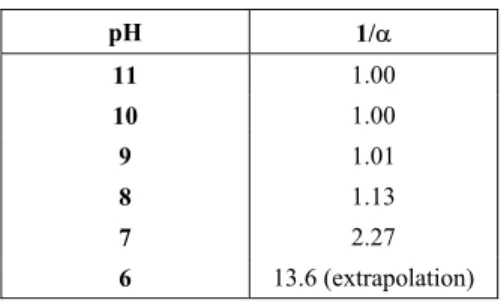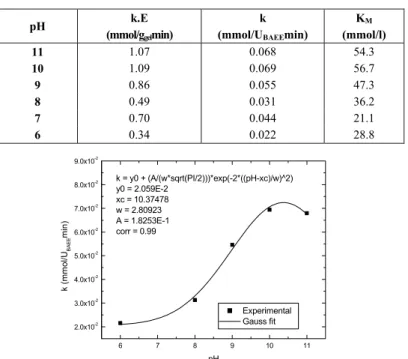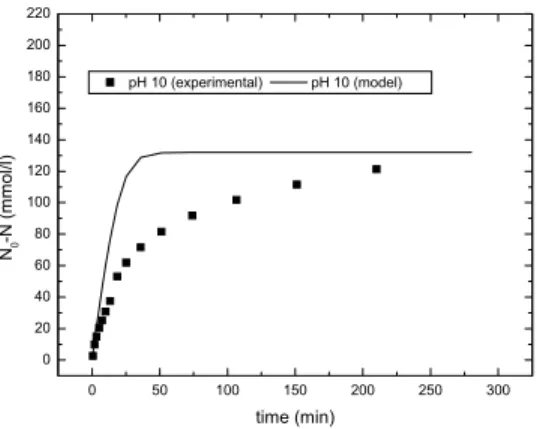ISSN 0104-6632 Printed in Brazil
Brazilian Journal
of Chemical
Engineering
Vol. 21, No. 02, pp. 147 - 153, April - June 2004
KINETIC MODEL FOR WHEY PROTEIN
HYDROLYSIS BY ALCALASE
MULTIPOINT-IMMOBILIZED ON AGAROSE GEL PARTICLES
R. Sousa Jr, G. P. Lopes, P. W. Tardioli, R. L. C. Giordano,
P. I. F. Almeida and R.C. Giordano
*Departamento de Engenharia Química, Universidade Federal de São Carlos, Fax: +(55-16) 260-8266, Cx.P. 676, 13565-905, São Carlos, SP, Brazil.
E-mail: roberto@deq.ufscar.br
(Received: February 13, 2003 ; Accepted: October, 3, 2003)
Abstract - Partial hydrolysis of whey proteins by enzymes immobilized on an inert support can either change or evidencefunctional properties of the producedpeptides, thereby increasing their applications. The hydrolysis of sweet cheese whey proteins by alcalase, which is multipoint-immobilized on agarose gel, is studied here. A Michaelis-Menten model that takes into account competitive inhibition by the product was fitted to experimental data. The influence of pH on the kinetic parameters in the range 6.0 to 11.0 was assessed, at 50oC. Initial reaction-rate assays in a pHstat at different concentrations of substrate were usedto estimatekinetic and Michaelis-Menten parameters, k and KM. Experimental data from long-term batch assays were used to quantify the inhibition parameter, KI.
The fitting of the model to the experimental data was accurate in the entire pH range.
Keywords: Enzymatic proteolysis, Michaelis-Menten kinetic model, competitive inhibition, whey hydrolysis.
INTRODUCTION
Cheese whey is a by-product of the dairy industry that for a long time has been considered a residue. However, its high BOD [35000 mg/l – compare, for example, with the 300 mg/l BOD of domestic drains (Viotto, 1993)] and the high cost of its treatment have stimulated the search for commercial uses for it or its derivatives (Demetrakakes, 1997).
Partial hydrolysis of whey proteins can either change or evidence the functional properties of the peptides in this industrial residue, thereby increasing their applications. Hydrolyzed cheese whey can be a suitable protein source for infants and for individuals with a reduced digestive capacity. A tailor-made hydrolysis with specific enzymes, followed by convenient downstream processes, can also reduce phenylalanine contents in the product, which would thus be fitted to the diet of phenylketonuria patients.
Products containing bioactive peptides that are free of any bitterness can be obtained by partial hydrolysis of cheese whey proteins, making use of different proteases (Mann, 2000).
Making use of a pHstat, it is possible to observe the progress of the reaction by monitoring the consumption of a titrant, necessary to control the system pH during batch hydrolysis assays carried out in a laboratory-scale reactor.
This work focuses on the case of whey protein hydrolysis by alcalase, multipoint-immobilized on agarose gel particles. Initial reaction-rate assays in a pHstat, with different substrate concentrations and different pH’s made it possible to estimate the Michaelis-Menten kinetic parameters as a function of pH. Long-term assays showed that a third additional parameter should be considered, that would take into account the inhibitory effect of the products. Data from long-term batch assays also permitted quantification of this additional parameter by the Marquardt algorithm (1963). Assays at pH 6, 7, 8, 9, 10 and 11 were carried out. All assays were run at 50oC, a temperature where high productivity is achieved without any significant loss of enzymatic activity (Lopes, 2001).
ENZYMATIC PROTEOLYSIS
In general, proteolytic reactions can be summarized as follows:
H2O
(carboxyl fragment) (amino fragment)
P1 - CO --- NH - P2 o P1 - COOH + NH2 - P2 (1a)
NH2 - P2 + H+ l NH3+ - P2 (1b)
and
P1 COOH l P1 COO- + H+ (1c)
According to Svendsen (1976) and Adler-Nissen (1986), it is generally accepted that serine proteases like alcalase, when acting on peptide bonds, follow Michaelis-Menten kinetics (see Equation 2, from Segel, 1975). Postolache and Oncescu (1989) also characterized the hydrolysis of casein and hemoglobin by alcalase according to Michaelis-Menten kinetic models.
M
k E N V
K N
(2)
On the other hand, it could be expected that the original substrate and some of the peptides that are
continuously released during the hydrolytic process would compete for the active site in the enzyme. Adler-Nissen (1986) and González-Tello et al. (1994) had already pondered the possibility of product inhibition. Equation 3 shows a Michaelis-Menten model with competitive inhibition (Segel, 1975).
M I
k E N V
I K (1 ) N
K
(3)
where N is the molar concentration of peptide bonds in the substrate that can be hydrolyzed by alcalase, I is the molar concentration of the inhibitor and k, KM
and KI are the kinetic model parameters. Alcalase
can hydrolyze about 25% of the total number of peptide bonds in the protein substrate.
When the pHstat technique is used, the consumption of base necessary for controlling system pH during the batch assay provides the degree of hydrolysis (DH) in a straightforward manner (Equation 4). The initial reaction rates can be determined from the base consumption during the initial minutes of each assay (Adler-Nissen, 1986).
b
tot tot
h 1 1 1
DH 100% B N 100%
h u u u uD MPuh u (4)
where htot is the total number of peptide bonds in the
protein substrate, in meqv/gprotein (or simply
mmol/gprotein); h is the number of hydrolyzed peptide
bonds; B is the base consumption in ml; Nb is base
normality;D is the average degree of dissociation of theD-NH groups and MP is the mass of protein in g.
Note that for the range of pH considered here, the carboxyl radical will be completely dissociated (reaction 1c will be displaced to the right). For this reason, the correction factor, D, only considers the equilibrium of reaction 1b.
MATERIALS AND METHODS
Cooperativa de Lacticínios São Carlos donatedin natura cheese whey, which was micro- (membrane A/G Technology Corporation, 0.45Pm) and ultra-filtered (membrane Amicon, 10000 Da) up to a concentration of 60 g/l.
Kinetic Model for Whey Protein Hydrolysis 149
was suspended in bicarbonate buffer 50 mM, pH 10 at a 1/10 ratio (Vgel/Vtotal). Then 100 Plalcalase/mlgel
were added to the suspension and maintained under gentle shaking at 20 qC for 24 hours. Then 1 mgsodiumborohidrete/mlsuspension was added, maintaining
the same stirring at 20 qC for 30 minutes. Finally, the reduced derivative was washed using distilled water in abundance.
In the jacketed reactor, coupled to the pHstat, the temperature of the concentrated cheese whey was raised to 50 qC and its pH adjusted by the manual addition of HCl and/or NaOH. The immobilized enzymes were then quickly added to the reactor and the automatic pH control of the equipment switched on.
Initial-rate assays for different substrate concentrations and pH’s made it possible to estimate the parameters k and KM of the Michaelis-Menten
kinetic model. Eighteen experiments lasting 15 minutes were carried out at T = 50 qC. In each assay, 15 ml of cheese whey (20, 40 and 60 g/l) and 0.04 g of gel containing 15.7 UBAEE/ggel were utilized. One
UBAEE (of alcalase) hydrolyzes 1 Pmol of benzoil
arginine ethylic ester per minute at pH 8 and 25oC. For each concentration, six pH values (6, 7, 8, 9, 10 and 11) were taken into account.
Four long-term hydrolysis experiments (lasting 5 hours) were also carried out, which made it possible to evaluate the adequacy of the pure Michaelis-Menten model, and subsequently quantify the parameter KI. In each assay, 30 ml of cheese whey at
60 g/l and 0.30 g of gel containing 13.4 UBAEE/ggel
were utilized. The assays were carried out at different pH: 7, 8, 9 and 10 (T = 50 qC).
Despite alcalase was immobilized on agarose gel particles, the vigorous stirring and high porosity of the gel substantially reduced convective and diffusive mass transport resistances. Therefore, we assumed that we were observing inherent reaction rates in our experimental conditions, i.e. free from mass transfer delays.
For pH control, NaOH 0.2 N or 0.5 N was utilized. For parameter D, the values presented by Adler-Nissen were adopted (1986) (Table 1).
For cheese whey, htot is 8.8 meqv/gprotein = 8.8
mmol/gprotein (Adler-Nissen, 1986).
Table 1: Calibration values for the pHstat (Adler-Nissen, 1986).
pH 1/D
11 1.00
10 1.00
9 1.01
8 1.13
7 2.27
6 13.6 (extrapolation)
RESULTS AND DISCUSSION
From the number of hydrolyzed peptide bonds per gram of gel calculated for the first minutes of reaction of the initial-rate assays, hg0 u time curves, like the
one shown in Figure 1, were built. Initial reaction rates (V0) were obtained by linear regression.
Making use of the Lineweaver-Burk equation [Equation 5 (Segel, 1975)], k and KM were estimated,
as shown in Figure 2.
M 0
K 1 1 V k E N k
1
E (5)
The results are presented in Table 2. Figures 3 and 4 show them graphically. The point
corresponding to pH 7 (an outlier) was discarded. It is important to note that assays with finely crushed gel particles indicated the absence of diffusion resistance effects, The experimental effectiveness factorKwas always essentially equal to unity, for the gel enzymatic load used here.
The curves in Figures 3 and 4 are typical results (activity and KM vs. pH).
The model was validated against long-term batch assays. Without the inhibition term, the predicted reaction rates were noticeably higher than the experimental. Figure 5 shows the model predictions and the experimental values for the number of peptide bonds hydrolyzed by the enzyme (N0 - N in
mmol/lsolution with N0 = 8.8u60u0.25 = 132 mmol/lsolution),
-1 0 1 2 3 4 5 -0.5
0.0 0.5 1.0 1.5 2.0 2.5 3.0 3.5
Y = -0.02451 + 0.7349 * X corr = 0.99
Experimental data Linear fit
h
g0
(m
mo
l/
gg
e
l
)
time (min)
Figure 1: Determination of initial reaction rate of whey protein (60 g/l) hydrolysis by alcalase immobilized on agarose gel particles at pH 10 and T=50oC.
0.005 0.010 0.015 0.020 0.025 1.2
1.4 1.6 1.8 2.0 2.2
Experimental Linear fit
Y = 0.91679 + 51.96926 * X corr = 0.99
-1
/V
0
(mi
n
.gg
e
l
/mm
o
l)
1/N (l/mmol)0
Figure 2: Lineweaver-Burk plot for whey protein hydrolysis by alcalase immobilized on agarose gel particles at pH 10 and T = 50oC.
Table 2: Michaelis-Menten kinetic parameters k and KM; whey protein hydrolysis
by alcalase immobilized on agarose gel particles; T=50oC.
pH k.E
(mmol/ggelmin)
k
(mmol/UBAEEmin)
KM
(mmol/l)
11 1.07 0.068 54.3
10 1.09 0.069 56.7
9 0.86 0.055 47.3
8 0.49 0.031 36.2
7 0.70 0.044 21.1
6 0.34 0.022 28.8
6 7 8 9 10 11
2.0x10-2
3.0x10-2
4.0x10-2
5.0x10-2
6.0x10-2
7.0x10-2
8.0x10-2
9.0x10-2
Experimental Gauss fit k = y0 + (A/(w*sqrt(PI/2)))*exp(-2*((pH-xc)/w)^2) y0 = 2.059E-2
xc = 10.37478 w = 2.80923 A = 1.8253E-1 corr = 0.99
k
(m
mo
l/
UB
AEE
mi
n
)
pH
Kinetic Model for Whey Protein Hydrolysis 151
6 7 8 9 10 11
25 30 35 40 45 50 55 60 65
Experimental Gauss fit KM=y0 + (A/(w*sqrt(PI/2)))*exp(-2*((pH-xc)/w)^2) y0 = 28.47757
xc = 10.32117 w = 2.85334 A = 103.37395 corr = 0.99
KM
(mmo
l/
l)
pH
Figure 4: Influence of pH on the kinetic rate constant (KM) for whey protein
hydrolysis by alcalase immobilized on agarose gel particles at T=50oC.
0 50 100 150 200 250 300 0
20 40 60 80 100 120 140 160 180 200 220
N0
-N
(
mmo
l/
l)
time (min) pH 10 (experimental) pH 10 (model)
Figure 5: Michaelis-Menten model predictions (without inhibition) and experimental values for the number of hydrolyzed peptide bonds for whey protein hydrolysis
by alcalase immobilized on agarose gel particles at pH 10 and T=50oC.
These data were used for adjusting KI. During the
fitting procedure, it was also possible to confirm the consistency of the values previously obtained for KM
and k. Table 3 shows the values of KI as a function
of pH. Each new acyl-terminal, produced after the hydrolysis of a peptide bond, may link to the enzyme active site (a serine), making a non-productive acyl-enzime complex. Therefore, I = (N0 – N).
Table 3: Inhibition parameter KI; whey protein hydrolysis by
alcalase immobilized on agarose gel particles; T=50oC.
pH KI(mmol/l)
10 7.0
9 4.0
8 1.2
7 0.8
6 7 8 9 10 11 0
2 4 6 8
Experimental Gauss fit KI=y0 + (A/(w*sqrt(PI/2)))*exp(-2*((pH-xc)/w)^2) y0 = 0.62455
xc = 10.35300 w = 2.24818 A = 18.90752 corr = 0.99
KI
(mm
o
l/
l)
pH
Figure 6: Influence of pH on the inhibition kinetic parameter (KI) for whey protein
hydrolysis by alcalase immobilized on agarose gel particles at T=50oC.
0 50 100 150 200 250 300 0
20 40 60 80 100 120 140 160 180 200 220
N0
-N
(
mmo
l/
l)
time (min)
pH 10 (experimental) pH 10 (model) pH 9 (experimental) pH 9 (model) pH 8 (experimental) pH 8 (model) pH 7 (experimental) pH 7 (model)
Figure 7: Michaelis-Menten model predictions (with inhibition) and experimental values for the number of hydrolyzed peptide bonds for whey protein hydrolysis
by alcalase immobilized on agarose gel particles at pH 10 and T=50oC.
Figure 7 shows the model predictions and the experimental values for the number of hydrolyzed peptide bonds for the long-term assays carried out in the pHstat.
It is possible to observe the very good agreement between model predictions and experimental data.
CONCLUSIONS
By making use of the pHstat technique and the Marquardt algorithm, it was possible to estimate kinetic parameters for the enzymatic proteolysis of cheese whey, using alcalase, multipoint-immobilized on agarose gel particles. A process of competition between the original substrate and the peptides that are continuously produced during the reaction brings about a substantial reduction in the reaction rates of proteolysis. Therefore, neither pure
Michaelis-Menten nor first-order kinetics could represent our data, although these are the two usual forms of rate equation proposed in the literature for enzymatic proteolysis. A kinetic model with product competitive inhibition, however, provided an accurate fit for our experimental data.
ACKNOWLEDGEMENTS
The authors acknowledge the support received from FAPESP, CNPq and PADCT/CNPq, Brazil. Cooperativa de Lacticínios de São Carlos (Brazil) kindly provided the cheese whey.
NOMENCLATURE
Kinetic Model for Whey Protein Hydrolysis 153
DH degree of hydrolysis
E enzyme contents in the agarose gel (UBAEE/ggel)
htot the total number of peptide bonds in the
protein substrate (mmol/gprotein)
h the number of hydrolyzed peptide bonds (mmol/gprotein)
hg0 number of hydrolyzed peptide bonds per
gram of gel calculated for the first minutes of reaction in the initial rate assays (mmol/ggel)
I molar concentration of inhibitor (mmol/l) k, KM kinetic model parameter and KI
MP mass of protein (g)
N molar concentration of peptide bonds in the substrate hydrolyzable by alcalase (mmol/l) Nb base normality
V proteolysis reaction rate (mmol/ggel.min) D the average degree of dissociation of D-NH
groups
K measured reaction rate/reaction rate in the absence of mass transfer effects
REFERENCES
Adler-Nissen, J., Enzymic Hydrolysis of Food Proteins. Elsevier Applied Science Publishers (1986). Demetrakakes, P., Waste Not, Want Not, Food
Processing, July, 75-79 (1997).
González-Tello, P., Camacho, F., Jurado, E., Páez, M.P. and Guadix, E.M., Enzymatic Hydrolysis of Whey Proteins, Biotechnology and Bioengineering,
44, 523-528 (1994).
Lopes, G.P., Estudo do Controle do pH da Hidrólise Enzimática de Soro de Queijo. Master´s thesis, Universidade Federal de São Carlos-São Paulo (2001). Mann, E., Whey Products and Their Uses, Dairy
Industries International, December, 13-14 (2000). Marquardt, D.W., An Algorithm for Least-Squares
Estimation of Nonlinear Parameters, J. Soc. Indust. Appl. Math., 11, 431-441 (1963).
Postolache, C. and Oncescu, T., Kinetics of Hemoglobin and Casein Hydrolysis Catalyzed by Alcalase, Revue Roumaine de Chimie, 34, 581-584 (1989). Segel, I.H., Enzyme Kinetics. A Wiley-Interscience
Publication (1975).
Svendsen, I., Chemical Modifications of the Subtilisins with Special Reference to the Binding of Large Substrates. A Review, Carlsberg Res. Commun., 41, 237-291 (1976).
Tardioli, P.W., Hidrólise Controlada de Proteínas do Soro Lático Usando Carboxipeptidase A e Agarose Imobilizadas Multipontualmente em Agarose. Ph.D Thesis, Universidade Federal de São Carlos-São Paulo (2003).
Viotto, W.H., Ultrafiltração de Soro Doce de Queijo Minas Frescal. Efeito de Pré-tratamento do Soro no Desempenho da Membrana de Ultrafiltração e na Composição e Solubilidade do Concentrado Protéico de Soro. Ph.D. Thesis, Universidade Estadual de Campinas-São Paulo (1993).



